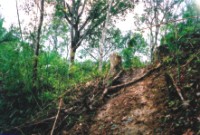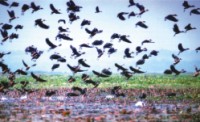|
Environment
Baikka Beel under Threat Paul Thompson
 |
Observation tower, Baikka Beel Sanctuary. |
Perhaps many people will think this is not the right question to ask. You might ask: “Should we save wetlands?”, or “Is it worthwhile to save them?” But those questions have already been answered. As a signatory to the Ramsar Convention on Wetlands, Bangladesh has already made an international commitment to ensure the wise use of its wetlands in general for the wellbeing of future generations. This includes, but is not limited to, protecting wetlands of international importance.
Even though millions of rural people for generations have depended on the beels, rivers, haors and other wetlands of Bangladesh for sources of food and income, at the policy level wetlands were misguidedly thought of as “wastelands”. Wetlands are in fact highly productive environments that support the livelihoods of millions in this country and often the poorest. A study of Hail Haor, a large wetland in Moulvibazar District, found that in 2000 the value of goods and services the haor averaged Taka 37,000 per hectare or double the return from the alternative of a single crop of dry season (boro) paddy at that time. So even without any improvements in management, wetlands are very valuable for the fish, aquatic plants, crops, grazing opportunities, flood mitigation and recreation they provide.
Over the last 20 years, just like everyone in this country I have seen wetlands drained or filled or silting up; seen embankments and roads marching across natural watercourses; seen more and more wetlands converted to agriculture, or fish ponds, or industry; held my nose because of polluted water around factories and towns; seen fewer water birds during winter surveys; and heard fishermen everywhere explain how their catches are a fraction of what they once were. These trends continue as very real threats to wetlands and their productivity.
 |
Deforestation causes increased siltation in the remaining wetlands. |
To take one example close to Dhaka, in Kaliakoir in Gazipur District, the number of textile related industries has increased tremendously from 12 in 1999 to 166 at the end of 2005, bringing much needed jobs and export earnings. But this has come at a high price. Even if those industries followed best practices so many would affect the local environment. In reality, very few have the effluent treatment plants they are required to operate. It is estimated that these industries discharge 30 billion litres of effluent water annually in the Turag-Bangshi wetland system. In this area the MACH project (Management of Aquatic Ecosystems through Community Husbandry) has worked with local communities to restore wetland productivity in the major beels, rivers and open flood land. This is a Government of Bangladesh project supported by USAID and implemented by Winrock International, Bangladesh Centre for Advanced Studies, Center for Natural Resources Studies, and Caritas Bangladesh working closely with the Department of Fisheries. Regular monitoring results indicate that pollution far exceeds national water quality standards there for several key indicators such as dissolved oxygen, in addition high concentrations of heavy metals such as chromium have been found in sediments. The result is fish kills and a threat to human health, although the industries could actually save money and reduce pollution by adopting better dyeing practices.
 |
Dredging is one way to restore silted up wetlands. |
Fortunately there are also examples of what can be done to save our fragile and threatened wetlands. One of the best examples is Baikka Beel within the greater Hail Haor wetland near Sreemongal. The local communities working with MACH project identified “Baikka Beel”, covering about 100 hectares as an area that could be protected without disadvantaging poor resource users who could fish and collect aquatic plants in other parts of the 3,000 ha of dry season water bodies in the haor. This was endorsed by the local government which made a proposal to the central government, and on July 1, 2003 the Ministry of Land decided to reserve the three jalmohals that form this beel as a permanent sanctuary, giving up an annual lease income of about one lakh taka. The sanctuary is protected by the local community through the Baragangina Resource Management Organisation (one of eight such organisations managing different parts of the haor). They now follow a management plan that was prepared through consultation with local people and is approved by a committee comprising of local officials, union parishad chairmen and leaders of community organisations. MACH has through the resource management committees and the local government, excavated deeper spots in the sanctuary, and planted native swamp forest trees to restore a greater diversity of habitats.
 |
Fulvous and Lesser Whistling Ducks, Baikka Beel Sanctuary. |
Since 2004 fishing, hunting, and collection of aquatic plants have been banned in the sanctuary by the community. The sanctuary has played an important role in increasing fish catches from the rest of the haor from 171 kg/ha before any interventions by MACH to 388 kg/ha. But this is not all, as a birdwatcher I have enjoyed a second dramatic effect which shows how the ecosystem health has been restored. Ask any local person around the haor and they will tell you, if you want to see birds then “Go to Baikka Beel”. The efforts by the community to stop poaching and hunting have succeeded. Already 103 species of birds have been recorded within the sanctuary. The mid-January 2007 waterbird census revealed 7,200 birds of 35 waterbird species. Recognising these attractions, MACH has helped to construct and equip an observation tower to help visitors see this spectacle without disturbing the area, the first such tower in a wetland in Bangladesh. Now in winter you can expect to see large flocks of local migrants such as Fulvous and Lesser Whistling-duck; long distance migratory ducks such as Northern Pintail and Common Teal, and residents such as Purple Swamphen. Some rare globally threatened species are now found, for example a few Pallas's Fish Eagles and Greater Spotted Eagles.
If wetlands are to survive and the people of Bangladesh are to continue enjoying the visual beauty of wetlands and the flavour of about 250 freshwater fish species, more needs to be done. Declaring areas to be protected is relatively easy, but the world is full of examples of areas that are protected on paper but where over exploitation and other degradation continue unabated. The real message from Baikka Beel is not just that wetlands can be protected and successfully restored, but how this can be done. Cooperation - between the poor and better off, between local leaders, councilors and officials - has been vital. A change in attitudes and understanding has been complemented by local community organisations taking up the challenge of planning and acting to overcome local problems, by work to improve the livelihoods of local poor people, and by formal collaboration between these communities and government. Both can now take pride in their joint achievements.
Bangladesh has a last chance to act now, before it is too late, to ensure that tomorrow's generations have a diverse range of fish to eat and water birds to see.
The writer is Senior Natural Resources Advisor at a USAID-funded project called MACH
Copyright
(R) thedailystar.net 2007 |
